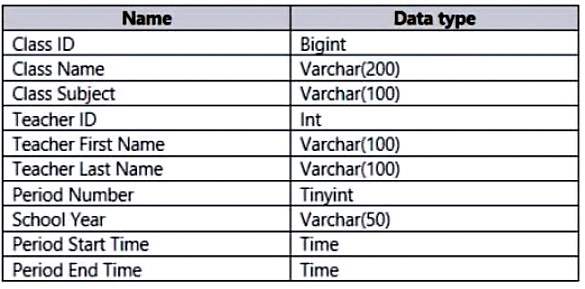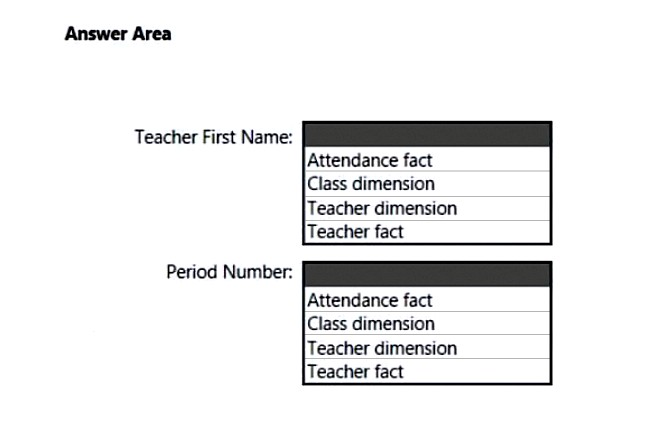

HOTSPOT -
You plan to create Power BI dataset to analyze attendance at a school. Data will come from two separate views named View1 and View2 in an Azure SQL database.
View1 contains the columns shown in the following table.
View2 contains the columns shown in the following table.
The views can be related based on the Class ID column.
Class ID is the unique identifier for the specified class, period, teacher, and school year. For example, the same class can be taught by the same teacher during two different periods, but the class will have a different class ID.
You need to design a star schema data model by using the data in both views. The solution must facilitate the following analysis:
✑ The count of classes that occur by period
✑ The count of students in attendance by period by day
✑ The average number of students attending a class each month
In which table should you include the Teacher First Name and Period Number fields? To answer, select the appropriate options in the answer area.
NOTE: Each correct selection is worth one point.
Hot Area:

Jukibabu
Highly Voted 2 years, 10 months agoJudT
1 year, 3 months agoAna_L
1 year, 4 months agoHoeishetmogelijk
2 years, 7 months agoRegina18
1 year, 6 months agoHoeishetmogelijk
2 years, 7 months agoRidderxxl
2 years, 4 months agosemauni
2 years, 2 months agoGPerez73
2 years, 10 months agoolajor
Highly Voted 2 years, 10 months agobirsne
2 years, 10 months agoTurmalino
2 years, 3 months agoa2c7cd3
Most Recent 2 weeks, 3 days agoa2c7cd3
2 weeks, 3 days agoa2c7cd3
2 weeks, 3 days agob92fc92
3 months, 2 weeks agoCurious236
4 months, 2 weeks agoaa83599
5 months, 3 weeks agojaume
7 months, 4 weeks agoTMOTM
10 months agoFrobeniusHammer
10 months agoAyman_Abdul_Kareem_1984
7 months, 3 weeks agoFrobeniusHammer
10 months agorcaliandro
11 months agogreenlever
1 year, 1 month agobugproof
1 year, 2 months agoshazzzy
1 year, 2 months agoshazzzy
1 year, 2 months agotarekff
1 year, 2 months agoZach0308
1 year, 2 months ago55884
1 year, 3 months agoGiuditta
1 year, 4 months agoAaronBI
8 months, 3 weeks ago